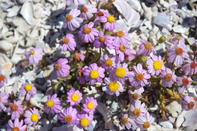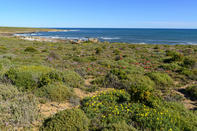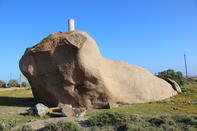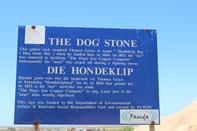Dog Stone Bay
Maybe it was the grey, inclement weather, but first impressions of Hondeklip Bay were not good. The sea was angry, the sky was brooding and the ramshackle collection of houses, plonked haphazardly in the sandy plain, were singularly unlovely. But then, the sun came out and the atmospheric surroundings slowly won me over.
Hondeklip Bay (Dog Stone Bay) gets its name from a small, canine-shaped rock that looks out to sea. The ‘ear’ of this formation was chopped off in the 1850s and sent to Cape Town as the emblem of the spurious ‘Dog’s Ear Copper Company’, which only succeeded in fleecing investors of their money before closing down. The rock was further damaged in 1970 when lightning struck off the ‘nose’, leaving behind a rather amorphous blob of gneiss. The rock is situated behind the police station on the edge of town.
Although this was once a bustling copper port, Hondeklip Bay is now a rather desolate place that is notable mainly for its wild, rocky coastline, excellent fishing and rusting shipwrecks that sprawl across the boulders like enormous steel carcasses.
A Rich Fossil Site
In terms of accommodation, there are a couple of private guest houses in Hondeklip Bay and the local council is busy establishing a community-run facility.
Hondeklip Bay is also a rich fossil site and several teeth from the prehistoric Megalodon shark have been unearthed along the beach. Crayfishing is popular in season (if you have a permit) and there are a number of 4x4 roads along the untouched coastline. So, check out this wind-tossed little settlement and experience the Namaqualand coast at its most unusual.
Leaving Hondeklip

As you leave Hondeklip, you can either head back towards the N7, or you can turn off to the south and head for the farms of Sarriesam and Soutfontein. This road is blocked by an interminable series of farm gates, but it offers a truly unembellished insight into the life of this rural community. Sparks of wildflowers tickle the eyes, with shrubs and succulents doing their utmost to attract their respective pollinators.
This part of the country is associated with the strange and sinister story of Robey Leibbrandt. He was a South African boxing champ who fell under Hilter’s spell during the 1932 Olympic Games in Munich. After the competition was over, Leibbrandt returned to Germany for training in espionage and was sent back to South Africa to assassinate General Jan Smuts and establish a new regime that was sympathetic to the Nazis.
He secretly put ashore somewhere in the vicinity of Hondeklip Bay and slowly worked his way down to Cape Town before moving to Pretoria. Amazingly, Leibbrandt came very close to achieving his goals but was brought down by his arrogance and stubborn refusal to follow the orders of his German masters.
Road to Groen River

Anyway, after about 70 km, the obscure farm roads reach an intersection with the ‘main’ gravel road to Groen (Green) River Mouth. This part of the road has some fantastic wildflower displays, but watch out for the deep cracks that creep across the roadway. If you hit one of these crevices at speed, you could flip the car or twist an axle – neither of which would be pleasant.
The Groen River mouth itself is apparently beautiful but I didn’t see it for myself because, when I was there, the Groen River was running very high over a low-level causeway and I chickened out from making the crossing. There are no facilities at Groen River Mouth, but you can camp here if you are self-sufficient. Apparently, there is a long-standing community of hippie-squatters living at the mouth, but the local municipality is trying to move them out.
When you are all done exploring this remote and fascinating part of the world, turn to the east and head back towards Garies and the N7.

